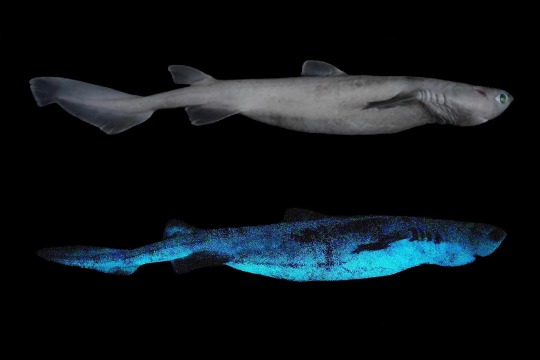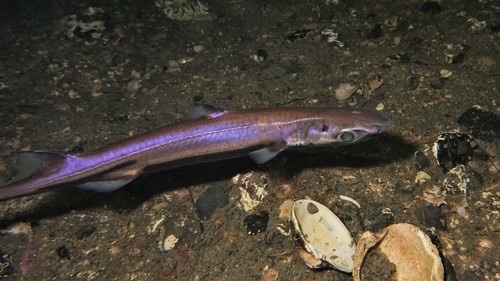#blackbelly lanternshark
Explore tagged Tumblr posts
Text

shark of the day: blackbelly lanternshark, etmopterus lucifer
------------------------------------------------------------
the blackbelly lanternshark, also called the lucifer shark, is a small species of lanternshark named for its dark underside and the dark stripe behind its pelvic fins. they can grow to measure around 47 cm(~1.6 ft) long. blackbelly lanternsharks are found primarily in the eastern pacific around new zealand and japan in deep water along the upper continental shelves. they feed on small bony fish, squid, and shrimps. like all lanternsharks, their undersides are covered in light-producing photophores that are bioluminescent.
25 notes
·
View notes
Note
May I see a blackbelly lanternshark? (ps - TIL that sharks are fish!)

fish 203 - blackbelly lanternshark
185 notes
·
View notes
Note
kirbyssharkfacts i am feeling down. will you give me a kirbys shark facts?
sorry to hear you're feeling down anon, but i hope this fact will help cheer you up! did you know some sharks can glow in the dark? bioluminescence has been documented in multiple shark species: the kitefin shark, blackbelly lanternshark, and southern lanternshark.

the exact purpose of this bioluminescence is unknown, but scientists have made several hypotheses. it’s possible that the sharks use this to communicate with each other, to disguise themselves when hunting prey or evading predators, or to illuminate the ocean floor when searching for food. a research paper on this subject was published in the frontiers in marine science journal in 2021, which you can find here if you're interested!
#asks#shark facts#marine biology#sea creatures#fun facts#sharks#kitefin sharks#blackbelly lantern sharks#southern lanternsharks#lanternsharks#lantern sharks#science
49 notes
·
View notes
Text

a blackbelly lanternshark!! [tsukihina]
279 notes
·
View notes
Text
there’s three known bioluminescent sharks. the kitefin shark, the blackbelly lanternshark, and the southern lanternshark. the kitefin shark is the largest known bioluminescent vertebrate.

kitefin shark ^

blackbelly lanternshark ^

southern lanternshark ^
#mikey’s sharks#shark facts#queued fact of the day#kitefin shark#blackbelly lanternshark#southern lanternshark#lanternsharks#sharks#ocean#marine biology
88 notes
·
View notes
Text
We Just Found The Largest Luminous Glowing Shark Species in The World
We Just Found The Largest Luminous Glowing Shark Species in The World
Good News Notes: “Three species of shark that inhabit the twilit depths of the ocean just turned out to have been bioluminescent this whole time. The kitefin shark, the blackbelly lanternshark, and the southern lanternshark have all been discovered to have softly glowing blue patterns on their skin, a first for sharks found in New Zealand waters. Of those three, the kitefin shark, which grows up…

View On WordPress
#bioluminescent#blackbelly lanternshark#discover#glowing#good news#happy#joy#kindness#kitefin shark#luminous#New Zealand#positive#sharks#southern lanternshark#species
0 notes
Text

i love this extra so much
#the blackbelly lanternshark is one of my favorite scenes of dialogue in all of hq!! tbh aslkjdaslds#hq#2021 reread#x
59 notes
·
View notes
Text
bioluminescent sharks exist isnt that neat?
35 notes
·
View notes
Note
Glow in the dark shark? 🥺
Yes, glow in the dark shark.
The year is 2020. You're on a research vessel off the coast of New Zealand near Chatham Rise to study the deep, dark sea and the sharks within it. By the end of the study, you have discovered another three sharks that are bioluminescent. That glow in the dark. They are the:
Kitefin Shark
Blackbelly Lanternshark
Souther Lanternshark
These three sharks join the other sharks that glow or produce their own light. With over 520 species of shark and around 57 of them capable of glowing/bioluminescence, approximately 10% of all known shark species glow in the dark.

Bioluminescence pattern of the Kitefin Shark
[image source: Mongabay news]
The next time you go in the ocean and think to dive deep, remember that the light you might see in the dark might not be the deep-sea Anglerfish but rather the Kitefin coming to say hello.
#Shark Facts#Bioluminescent sharks#I think glow in the dark sharks are amazing ngl#Kat talks#Kat replies#Kat answers#sharkbeneaththelotus
165 notes
·
View notes
Text

Mallefet et al., Front. Mar. Sci., 2021
Glow-in-the-dark sharks
Scientists have found three species of sharks living in the deep waters off the east coast of New Zealand that glow in the dark. Many marine animals can produce light through a process known as bioluminesce, but this is the first time that the phenomenon has been observed in the kitefin shark ( Dalatias licha), the blackbelly lanternshark ( Etmopterus lucifer) and the southern lanternshark ( Etmopterus granulosus). At a length of up to 180 centimetres, the kitefin the biggest luminous vertebrate known. The glowing underbellies could camouflage the sharks from predators from below, disguise them when approaching prey or help to illuminate the dark ocean floor. - Nature
1 note
·
View note
Text
The World's First Giant-Glowing Bioluminescent Shark Found
The World’s First Giant-Glowing Bioluminescent Shark Found
The World’s First Giant-Glowing Bioluminescent Shark Found There are a number of deep sea creatures that glow-in-the-dark, but a team studying marine life have the first ‘giant luminous shark.’ Researchers spotted the kitefun shark off the eastern coast of New Zealand during a survey last year, along with two others – a blackbelly lanternshark and southern lanternshark, which also posses…

View On WordPress
0 notes
Text
We just found the largest luminous glowing shark species in the world
https://sciencespies.com/nature/we-just-found-the-largest-luminous-glowing-shark-species-in-the-world/
We just found the largest luminous glowing shark species in the world

Three species of shark that inhabit the twilit depths of the ocean just turned out to have been bioluminescent this whole time.
The kitefin shark, the blackbelly lanternshark, and the southern lanternshark have all been discovered to have softly glowing blue patterns on their skin, a first for sharks found in New Zealand waters.
Of those three, the kitefin shark, which grows up to 180 centimetres (5 feet 11 inches) long, is now the largest known bioluminescent shark in the world.
Bioluminescence is not an uncommon trait for living things to evolve. Even humans glow (although too faintly to actually see). It seems to be most useful for life forms that live in the dark – night-glowing fungus, insects in dark caves… and in the depths of the ocean, so deep that the rays of the Sun can’t penetrate the water.
In the mesopelagic, also known as the twilight zone, between 200 and 1,000 metres (650 and 3,300 feet) below the surface, bioluminescence is practically a way of life. It has been estimated that over 90 percent of all mesopelagic animals have some form of bioluminescence that they use in different ways.
In sharks, however, bioluminescence is not well-documented, nor extensively studied. Marine biologists Jérôme Mallefet and Laurent Duchatelet of the Universit�� catholique de Louvain in Belgium have been leading an effort to redress this.

The kitefin shark glow pattern. (Mallefet et al., Front. Mar. Sci., 2021)
“Bioluminescence has often been seen as a spectacular yet uncommon event at sea,” the researchers wrote in their paper, “but considering the vastness of the deep sea and the occurrence of luminous organisms in this zone, it is now more and more obvious that producing light at depth must play an important role structuring the biggest ecosystem on our planet.”
Together with Darren Stevens of the National Institute of Water and Atmospheric Research (NIWA) in New Zealand, they undertook a study of the mesopelagic sharks found in local waters.
Thanks to their work, we now know that the kitefin shark (Dalatias licha) – which has a global distribution – is indeed bioluminescent, something that scientists had suspected since the 1980s, although no clear evidence had been found.
The other two sharks, the blackbelly lanternshark (Etmopterus lucifer) and the southern lanternshark (E. granulosus), are much smaller than the kitefin, up to 47 and 60 centimetres respectively, but they’re also the most common shark by-catch species found in New Zealand deep-sea trawlers.
The scientists caught their specimens on a NIWA survey trawl of Chatham Rise off the east coast of New Zealand in January 2020. Of the hundreds of sharks caught, 13 kitefin sharks, 7 blackbellies, and 4 southern lanternsharks were used for the bioluminescence study.
In the skin of all three species, the scientists found photophores, a light-emitting organ found in bioluminescent animals.
Curiously, in sharks the light emission is controlled hormonally (the only known animal species for which this is the case). The researchers found that with their three shark species, melatonin triggers the glow, alpha-melanocyte stimulates it, and adrenocorticotropic hormones shut it down.
As for why the sharks glow, that is not quite so easy to ascertain. Mesopelagic animals can glow for many reasons: attracting a mate, luring prey, schooling, or camouflage.
The scientists think for their sharks it might be the latter reason. The glow is concentrated around the bellies and undersides, and in the mesopelagic, this could help make these fish virtually invisible from certain angles.

The blackbelly lanternshark. (Mallefet et al., Front. Mar. Sci., 2021)
It’s not quite deep enough where the sharks hang out for no light at all to penetrate; to prey animals swimming underneath the sharks, they could appear silhouetted against the sky. But when their bellies light up blue, they would be much harder to see against the blue sky – a type of camouflage known as counterillumination.
That said, the glow on the dorsal fins of the kitefin shark is a little more difficult to puzzle out; more research into their behaviour is needed.
Understanding these creatures, the researchers said, could provide some insight not just into the individual species, but how the deep-sea ecosystem works as a whole.
“This first experimental study of three luminous shark species from New Zealand provides an insight into the diversity of shark bioluminescence and highlights the need for more research to help understand these unusual deep-sea inhabitants: the glowing sharks,” they wrote in their paper.
The research has been published in Frontiers in Marine Science.
#Nature
0 notes
Text

larger drawings of hiya kitty, tika-chu, and a blackbelly lanternshark are at the end of the chapter with a fun fact about each, too! what the fuck is wrong with them. not the blackbelly lanternshark, shes beautiful. hiya kitty and tika-chu

this is so fucking funny
30 notes
·
View notes
Text

honestly, same yachi. i also get distracted by the blackbelly lanternshark
#i dont even have anything to add lol i just find this panel really entertaining for no real reason#hq#yachi#shimizu#2021 reread#x
38 notes
·
View notes
